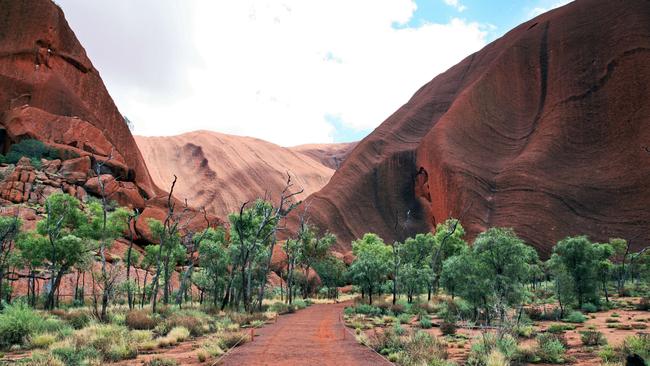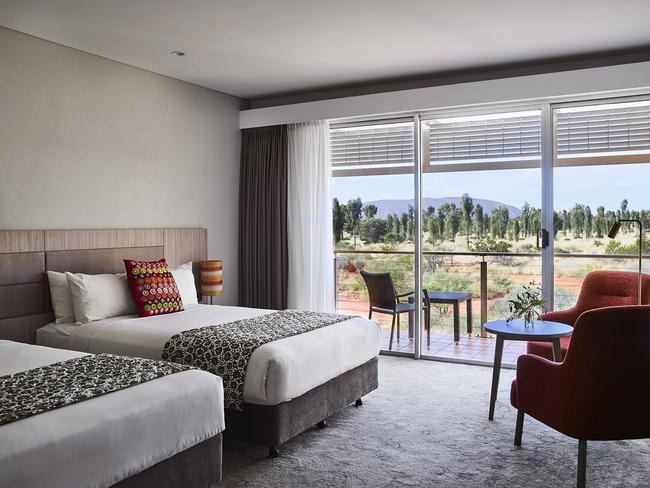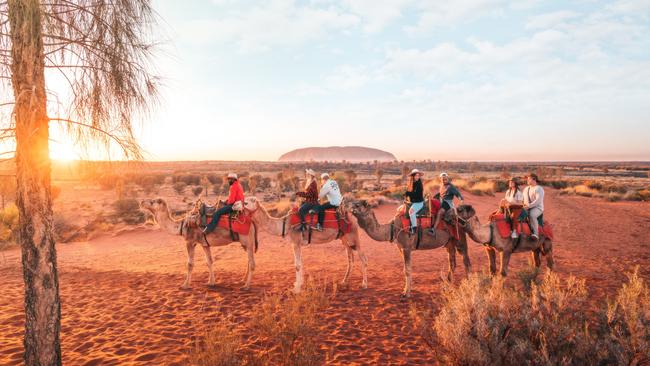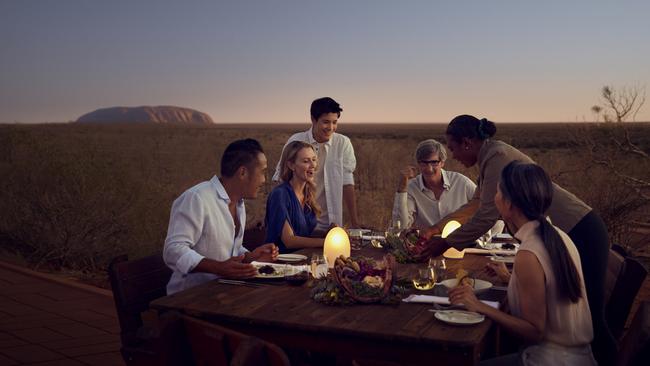Uluru and Kata Tjuta: how to experience them in style
There’s never been a better time to see the jewels of the Outback, Uluru and Kata Tjuta. So what are you waiting for?

A squadron of budgerigars flashes yellow and green as it rockets through the blue-black shadows of a gap in the ancient rock – one of many surprises during my first close encounter with Uluru. After four parched years, good rains have breathed life into this national icon and cryptic critters are reproducing in niches all over it, from shield shrimps and burrowing frogs to microbats and bottle swallows.

Uluru-Kata Tjuta National Park is a living place, not just for the birds and bees but for the Anangu people whose story is at Uluru’s heart. From a distance, though, it can seem a little foreboding. My second-storey room at Desert Gardens Hotel offered a splendid balcony profile of the red rock, but I’d been eager to get up close and personal. After the easy 20-minute drive to the rock’s base from Yulara, the desert resort town, we walked down a track leading to the Mutitjulu waterhole. As I approached, finch families flew nervously down to the water’s edge for a drink. They fluttered away and landed along grass stems, weighing them down like kids on a seesaw.
Hikers who complete the 10km walk around the base are retracing the steps of nomadic families who made Uluru home in certain seasons. On the Mala Walk, you enter caves where a smooth, flat rock was used to grind seeds; elsewhere is Kitchen Cave where women prepared food, and an Old Men’s Cave chosen so elders could easily enter. Ancestral life and creation stories are embedded in many rock features, which Parks Australia ranger Meegan Ebert says can make photography a tricky issue. Out of respect, visitors are asked to avoid taking photos in certain places; thankfully they are well signposted, yellow lines along certain parts of the road denoting “no stopping zones” for photographers.
We drive past a huge pillar of stone sitting proud of the rock face. “It’s said to be a ceremonial pole erected by the Mala men when they first arrived here,” says Ebert. It can’t be photographed, “but it becomes more special when you come here and see a feature you won’t have seen in any photograph”.

Ebert adds that she far prefers the Uluru of today compared with the days she was a tour guide and tourists still climbed the rock. “You saw crazy things – I saw a guy take a mountain bike up there, or people trying to push prams or carry up their newborn babies.” That chapter closed in late 2019; soon a native bush garden will be planted to erase evidence of the climb site.
And then there’s Uluru’s astonishing geological story. Who knew it was lying on its side? “It was pushed up out of the earth 250-300 million years ago,” says Ebert, “under uneven pressure that caused it to be pushed up on its side almost a full 90 degrees.”
Of course, the Anangu people see other things, and excellent signage gives clues. “Look at Uluru through our eyes… [at] rock formations that relate to Minyma Kuniya and Wati Liru, the woma python woman and poisonous snake man,” one reads. “This is a place of great history, an important place.”
Uluru and Kata Tjuta, the companion rock formation 50km away, seem to seduce you into taking dawn and dusk shots. Luckily, you get two-for-one at the Kata Tjuta sunrise viewing platform. We stand in the chilly dawn watching the gold light paint Kata Tjuta’s “many heads” peaks, and then swivel right to see exactly which part of distant Uluru the sun is striking. On this day, a red fireball appears at the far-left tip of the base, as if peeking around the rock before rising.
“You’ve got to have a big horizon to notice just how much the angle of the sun changes throughout the year,” says tour guide John Alderton, from SEIT tours. “I’ve got photos of it rising precisely in the middle.” He sets out a substantial breakfast on picnic tables before we head into Kata Tjuta’s Walpa Gorge for an easy walk between its two tallest domes.
In pre-Covid times, when 400,000 visitors arrived annually, cars would stretch back a kilometre waiting to get into the park before daybreak, and at the Kata Tjuta platform 300 people jostled to get the best sunrise shot. Maybe those years of heavy human traffic explain why the Cultural Centre, a five-minute drive from the rocks, looks shabby. Two shops inside sell local Indigenous art, but a livelier art encounter is to be had at Yulara.
On the shady lawn of the town square, Anangu-owned Maruku Arts holds dot-painting workshops twice daily. A Perth couple struggles to place four dots in a line but they’re delighted to endure the giggles of expert women painters giving them a lesson. There’s no clutter of buildings at Yulara, no unsightly barrier between it and the golden spinifex and spindly desert oak landscape that extends all the way to Uluru. Whether you stay in self-catering apartments or more upmarket hotels, they all connect to cafes, restaurants and souvenir shops through shaded alleyways and dry riverbed gardens.
“Rock-in-the-distance” photo opportunities are many and tours invariably good value. The Field of Light Sunset Tour is a must-do, involving a chilled glass of sparkling wine, canapes and a view of Uluru from a sand dune. As night falls, a field of dancing illuminated desert flowers becomes visible below. The creation of English artist Bruce Munro, the flowers bob and shimmer in the breeze. Close inspection shows they are actually 50,000 glass globes on stems, colourfully lit by a tangle of optic fibres. Your eye convinces you the fields go all the way to the foot of a grand monolith as enduring as the lights are ephemeral.
Sam and Aymeric from Brisbane describe Uluru as a brilliant desert experience on a par with their trip to Jordan. Their Sounds of Silence dinner was a favourite, “where between courses they turn off the lights and give a tour of the stars with an astronomy expert – that was 10 out of 10”, says Sam.

My evening highlight is Tali Wiru, a sublime four-course dinner that begins with canapes around a firepit with an enchanting view of that Uluru sunset from the top of a dune. The canapes are little jewels: dense seed cakes with orange myrtle fig and a purple dried petal, or wallaby and quandong fingers laid on black and white stones. A spinifex hopping mouse grazes daintily on our dropped sesame seeds.
Korean chef Kim, immaculate in chef’s garb and cloth cap, leaves his lean-to pavilion kitchen to explain ingredients such as finger lime caviar in the prawn dish and desert plum in the beetroot mousse. “This is samphire, which grows on the mudflat, a little bit salty in flavour,” he says. “It will be in your toothfish tonight.” Every dish is perfectly matched with South Australian wines and served by graduates from the Yulara-based National Indigenous Training Academy, which trains 80 young people in hospitality each year and runs the Kulata Academy Cafe.
Early rising is always rewarding, but I’m less sure of an Uluru dawn from the back of a one-humped dromedary. Yet our camel train of a dozen animals – all castrated males, poor sods – plods along sandy tracks adorned with gorgeous wildflowers, and even the saltbush seems to sparkle. It’s made all the prettier by the rise and fall of sand dunes, and Uluru’s distant outline.
I introduce myself to solo traveller Michelle, who swings onto Tim Tam behind my man Curly. She says Central Australia offers heaps of good tours in her price range of $100-250. She’s done every available tour and praises SEIT tours “because I get transport, food and drink and company, all in one”.
• Perfect for: Adventurers, tour lovers, hikers.
• Must do: Enjoy the visual feast of Field of Light; take in a dot painting workshop (maruku.com.au); join an Uluru sunrise tour; take the shuttle bus to Uluru Camel Farm. Buy a painting from the new Gallery of Central Australia at Yulara, which sources works from the region’s remote art centres. SEIT offers a range of guided small-group tours (seitoutbackaustralia.com.au); for others go to ayersrockresort.com.au
• Dining: Invest in at least one outdoor culinary treat such as Tali Wiru (sunset bubbles and canapes, four-course dining on a dune with views, didg performance and indigenous storytelling, from $380pp, season permitting) or Sounds of Silence (dune-top buffet dinner and more, from $229pp). Try the pancake breakfasts at Sails in the Desert’s Ilkari restaurant and delicious poke bowls at Desert Gardens’ Mangata Bistro.
• Getting there: Uluru is 443km southwest of Alice Springs, a four-hour drive by car or tour bus.
• Bottom line: Desert Gardens Hotel from $320pp per night. For more options, from camping to Sails in the Desert (from $475pp), go to ayersrockresort.com.au.
northernterritory.com


